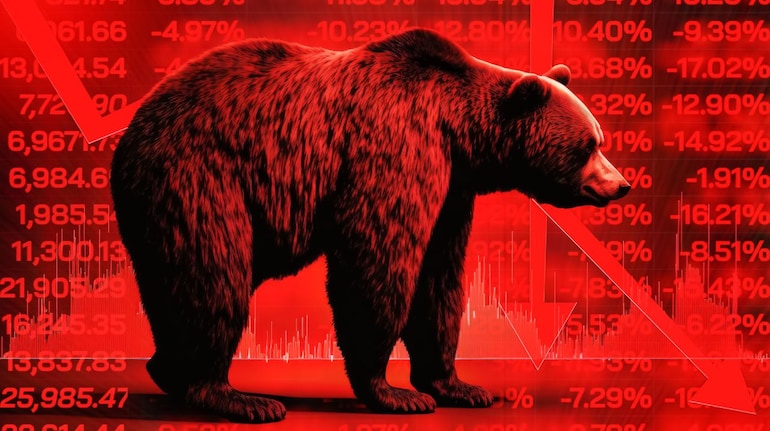U.S. markets endured a significant downturn on Tuesday, continuing a stretch of intense volatility as the Trump administration followed through on a controversial trade move initiated originally during his first presidential term. A dramatic escalation in tariffs on Chinese imports—raising the total tariff burden to an eye-watering 104%—triggered sharp losses across major indexes, sparked chaos in the bond market, and rippled through oil and tech stocks.
Tariff Tensions Sink Major Indexes
Markets opened the day with a burst of optimism but quickly reversed course as the White House confirmed its intention to impose additional levies on Chinese goods. The S&P 500 flirted with bear market territory after falling nearly 1.6%, and the Nasdaq Composite dropped approximately 2.2%. Meanwhile, the Dow Jones Industrial Average slipped by over 300 points—losing 0.8%—after gaining more than 1,300 points earlier in the session.
This marked the third consecutive day of wild market swings, a phenomenon that, according to Yahoo Finance data, has only occurred during some of the most severe financial crises in recent memory—specifically, the 1987 crash, the 2008 global financial crisis, and the initial pandemic lows in 2020.
White House Stands Firm
Despite market turbulence and growing concern among investors, the White House remained resolute. Press Secretary Karoline Leavitt defended the move, stating, “Americans do not need other countries as much as other countries need us. President Trump has a spine of steel and he will not break.”
The message signaled that the administration had no plans to walk back or moderate the tariff escalation, even as global markets reacted nervously.
Apple, Tech Stocks Feel the Heat
Tech giants were among the biggest casualties of the tariff escalation. Apple (AAPL), which manufactures a significant share of its products in China, initially rallied early in the session but fell back sharply after the official announcement. Shares had climbed to $190.34 in morning trading but reversed as investor anxiety surged.
The additional 50% tariff announced this week added to the previous 54% already in place, making Apple’s cost structure increasingly uncertain. Despite efforts to diversify its supply chain by moving some manufacturing to India, Apple remains heavily reliant on Chinese factories—an exposure that is now proving costly.
Oil Markets React Sharply
Oil prices also felt the sting. Brent crude fell by over 2.5%, settling at $62.82 per barrel, while West Texas Intermediate (WTI) dropped to $59.58, marking its lowest close since 2021. Since Trump first floated the possibility of retaliatory tariffs against China and other nations on April 2, oil has plummeted more than 15%.
China, the world’s largest oil importer, retaliated last week with a 34% levy on U.S. goods. President Trump responded with another 50% tariff threat if China did not roll back its own measures, further clouding the outlook for global trade and commodity prices.
Bond Market Turmoil
The U.S. bond market reflected the same tension, with yields soaring in response to the geopolitical and economic uncertainty. The 10-year Treasury yield spiked dramatically from 3.87% to as high as 4.25% over just two days—a massive shift for a market that typically prizes stability.
Likewise, the 30-year yield rose by 12 basis points on Tuesday alone, hitting 4.72% by late afternoon. According to market strategist Jim Bianco, a swing of this magnitude—in which the 10-year yield falls significantly intraday only to close much higher—has only occurred three times since 1998.
“This doesn’t necessarily predict where the market is heading next,” Bianco commented on social media platform X, “but it signals just how important today was for the bond market.”
Mixed Signals from the Administration
Though Treasury Secretary Scott Bessent tried to calm nerves by announcing the start of bilateral trade talks with Japan, confusion still reigned. While some interpreted the move as a sign that the U.S. was willing to engage in negotiations, others pointed to Trump trade adviser Peter Navarro’s firm stance that the tariffs were “not a negotiation,” but rather a strategic stand.
Beijing has vowed to retaliate further if the U.S. continues what it labels “blackmail,” promising to “fight to the end.” That rhetoric has only increased fears of a prolonged and damaging trade conflict.
Health Sector Sees a Rare Win
Amid the broader market decline, one sector managed to post notable gains. Health insurance providers soared after the administration announced increased Medicare Advantage reimbursement rates set for 2026. Humana jumped 11%, CVS Health rose 8%, and UnitedHealth Group gained 7%.
These moves made health insurance stocks the rare winners in an otherwise bearish session, reflecting investor confidence that the sector could benefit from more favorable federal policies.
Wall Street, however, is preparing for a rocky road ahead. Whether negotiations can ease tensions—or if more turmoil lies ahead—remains to be seen. For the average investor, terms like correction, crash, and bear market can feel interchangeable—but they’re not. A correction is a short-term drop of at least 10%, often seen as a natural pause or “cooling off” in an overheated market. A crash is a fast, sharp drop that usually stems from sudden shocks like unexpected economic news or geopolitical events. A bear market, meanwhile, is a longer-term decline of 20% or more, often tied to deeper economic issues and lasting investor pessimism. According to Andreas Jones of KindaFrugal, recognizing the differences matters because each demands a different mindset and strategy—what you do in a correction may not be what you should do during a bear market.
For consumers and long-term investors alike, the key takeaway is this: downturns are part of the market’s rhythm. Trying to time the market or reacting emotionally to headlines can do more harm than good. Instead, focus on your financial goals, build a diversified portfolio, and remember that the market has historically recovered from every downturn. Whether you’re investing for retirement, your child’s education, or just building wealth over time, staying informed and calm is your best financial defense.

